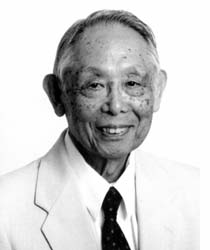 |
 |
|
 |
 |
 |
 |
 |
|
 |
 |
 |
 |

For further MBL News and Media Information, contact the MBL Communications Office at (508) 289-7423 or e-mail us at
.
September 17, 2003
MBL Distinguished Scientist Shinya Inoué Awarded 2003 International Prize for Biology
 Woods Hole, MA- The Japan Society for the Promotion of Science (JSPS) has announced that Shinya Inoué, a Distinguished Scientist at the Marine Biological Laboratory (MBL) in Woods Hole, Massachusetts, will receive the prestigious 2003 International Prize for Biology at a ceremony that will be held later this fall in Tokyo. Woods Hole, MA- The Japan Society for the Promotion of Science (JSPS) has announced that Shinya Inoué, a Distinguished Scientist at the Marine Biological Laboratory (MBL) in Woods Hole, Massachusetts, will receive the prestigious 2003 International Prize for Biology at a ceremony that will be held later this fall in Tokyo.
The International Prize for Biology is awarded annually by the JSPS to an individual who, "in the judgement of the members of the Committee, has made an outstanding contribution to the advancement of research in fundamental biology." The Prize, which commemorates the 60-year reign of Emperor Showa and his longtime devotion to biological research, consists of a medal and a cash award.
Dr. Inoué will receive his award at a ceremony at the Japanese Academy in Tokyo on December 1st. The Emperor and Empress of Japan, the Prime Minister of Japan and other dignitaries are scheduled to participate in the ceremony. A two-day symposium honoring Dr. Inoué's work titled "Cellular and molecular dynamics revealed by advanced light microscopy" will follow. Symposium speakers include Ron Vale, University of California, San Francisco; Ted Salmon, University of North Carolina; Roger Tsien, University of California, San Diego, and Jeff Lichtman, Washington University.
For nearly 60 years, Dr. Inoué's research has helped influence and shape our understanding of basic cellular processes and structures. He is known internationally for his expertise in cellular and developmental biology and in experimental optical instrumentation.
Dr. Inoué's distinguished career began in the 1940s at Tokyo University where he studied with MBL investigator Katsuma Dan and became obsessed with observing the structures and mechanisms of the living cell. Today, as Distinguished Scientist at the MBL he continues to be interested in development-the processes by which a single fertilized egg divides and redivides, giving rise to millions of specialized cells that form the organs of a complex, living organism. His dual careers as microscopist and cytologist have been elegantly complementary: each refinement of his microscope has led to a better understanding of the processes that occur during and after fertilization.
In the late 1940s, he was one of the first cell biologists to make extensive use of polarized light microscopy, having fashioned his first microscope out of scraps of metal and a machine gun barrel left behind from WWII at the Misaki Marine Biological Station. His landmark discovery in 1951 of the delicate spindle fibers responsible for moving chromosomes within the cell during cell division provided invaluable insights into the mechanisms of mitosis.
During mitosis, the cell divides-as a means of reproduction-into twin daughter cells that contain identical genetic information. This information is carried on rod-shaped bodies known as chromosomes. How the chromosomes actually moved was unclear until Inoué, working as a graduate student from Princeton at the MBL, documented the presence of the slender spindle fibers with his polarizing light microscope. Before this discovery, cell biologists had waged a fifty-year debate about whether the fibers were real structures or artifacts.
Inoué continued to fine-tune his microscope in his quest to answer biological questions. In 1980 he made one of the most simple, yet profound, refinements to his microscope. He added a video camera. Inoué found that by adjusting the contrast and "black level" knobs of a video camera attached to the microscope he was able to see more detail within a cell than was ever imagined. When he peered into the oculars of the microscope he saw nothing but gray noise, but a glance at the monitor attached to the video camera revealed, in the same specimen, the pulsating movement and minute structures of cellular life. The camera was able to see what the human eye could not. The discovery revolutionized the fields of light microscopy and cellular and molecular biology.
Inoué received his M.S. and Ph.D. from Princeton University. Before moving to the MBL permanently in 1978, Dr. Inoué held a number of academic positions at the University of Washington Medical School, Tokyo Metropolitan University, University of Rochester, Dartmouth Medical School and the University of Pennsylvania. He was elected to membership in the National Academy of Sciences in 1993 and has received numerous awards throughout his career, including the Distinguished Scientist Award from the Microscopy Society of America and the E.B. Wilson Award from the American Society for Cell Biology.
A member of the MBL Corporation since 1962 and former member of the MBL Board of Trustees, Dr. Inoué has shared his expertise with generations of students as a member of the faculty of many MBL Courses including Embryology, Physiology, and Optical Microscopy.
Dr. Inoué's Architectural Dynamics in Living Cells Program at the MBL was established in 1992.Ê This program focuses on learning more about the timely and coordinated assembly and disassembly of macromolecular structures essential for the proper functioning and differentiation of cells, the spatial and temporal organization of these structures, and their physiological and genetic control. The program is also devoted to the development and application of powerful new imaging and manipulation instruments and devices that permit such studies directly in living cells and functional cell-free extracts.
The Marine Biological Laboratory, located in Woods Hole, Massachusetts, is an independent scientific institution, founded in 1888, that undertakes the highest level of creative research and education in biology, including the biomedical and environmental sciences.
|
| |
  |
|
 |
 |
|